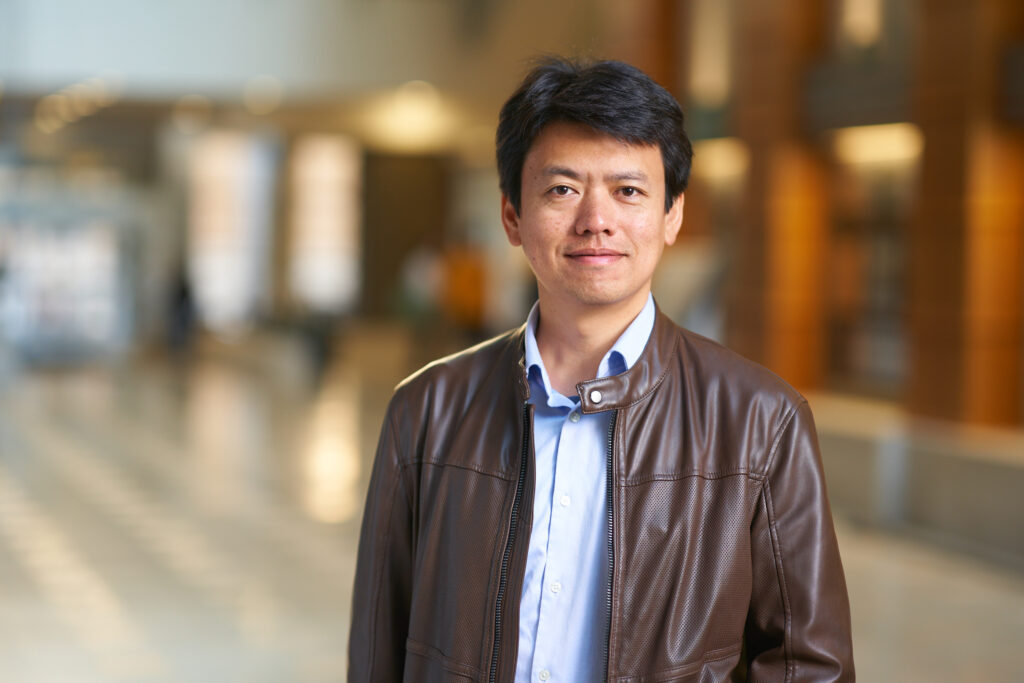Research focuses on a better understanding of learning and prediction.

Cheng Huang, PhD, has won a Whitehall Foundation grant to study the neural mechanisms of prediction using Drosophila (fruit flies) as a powerful model to understand analogous processes in the human brain.
“Receiving this Whitehall Foundation grant is an incredible privilege and an exciting opportunity for our new lab,” said Huang, an assistant professor of neuroscience at WashU Medicine. “This critical funding will help us to launch our research program investigating how neural systems generate predictions. We will apply novel imaging techniques to explore the role of dopamine signaling in learning and prediction in the fruit fly brain. We are deeply grateful to the Whitehall Foundation for recognizing the importance of this research and for their belief in our vision.”
The brain is a prediction machine, constantly anticipating what will happen next based on past experiences and current situations, Huang said. For this project, the Huang Lab will use cutting-edge imaging techniques to focus on how dopamine neurons light up as flies learn and make predictions. The research could uncover fundamental rules governing how brains anticipate the future.
The new research builds upon the Huang Lab’s previous work with fruit flies. It uses genetically encoded fluorescent reporters to monitor dopamine and voltage dynamics of dopamine neurons. This work will elucidate the conserved role of dopamine in learning and decision-making processes shared by humans and fruit flies.
Huang’s experiment includes mounting the flies on an air-suspended trackball so they can move with their legs. The flies are then trained to approach or avoid different foods based on odor cues. All the while, neural activity in the flies’ brains is monitored using a fluorescent microscope above their heads.
The project focuses on two distinct populations of dopamine-releasing neurons — one involved in positive reinforcement learning and one in negative learning.
The novel experiment design features a delayed reward paradigm that will allow Huang to determine if dopamine neurons convey the reward prediction errors as observed in mammalian brains and how these neurons generate such predictions.
“Recent breakthroughs have allowed us to map and monitor the activity of individual neurons in flies as they learn,” Huang said. “This provides a unique window into the basic mechanisms of prediction, which are likely shared across species, including humans. Understanding how these tiny brains predict could reveal secrets about decision-making, habit formation and even addiction in human brains. It may eventually lead to new therapeutic strategies for neurological disorders linked to dopamine dysfunction.”
Huang’s fascination with memory began with childhood experiences. He recalls how a faint scent of paprika could instantly transport him back to his grandfather’s kitchen, flooding his mind with vivid memories of his favorite dishes and family holiday gatherings. He wondered: How could a simple sensory cue unlock such a rich tapestry of stored information? The question sparked a lifelong quest to understand the neural mechanisms of learning and memory.
While a postdoc in the Schnitzer Lab at Stanford University, Huang helped develop cutting-edge imaging techniques for neuroscience studies and later adapted these imaging tools for fruit flies, opening exciting new possibilities for studying memory at the single-neuron level.
Huang is furthering that early-career research with assistance from the Whitehall Foundation, a not-for-profit corporation supporting basic research in vertebrate (excluding clinical) and invertebrate neurobiology in the U.S.
“As a new investigator, this funding is crucial for establishing my lab and pursuing my research direction,” Huang said. “It provides the necessary resources to conduct pilot experiments to lay the foundation for future studies. The preliminary data and publications generated with this support will strengthen my applications for larger grants from federal agencies like the NIH. This award is a critical stepping stone to securing long-term funding for my research program. With the support of the Whitehall Foundation, I can further pursue using the fruit fly as a model to unravel the intricate interactions among neurons that allow us to learn and remember.”